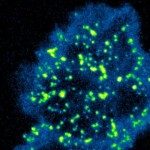Link to Pubmed [PMID] – 22105350
Link to DOI – 10.1083/jcb.201103105
J. Cell Biol. 2011 Nov; 195(5): 839-53
Antigen recognition within immunological synapses triggers and sustains T cell activation by nucleating protein microclusters that gather T cell receptors (TCRs), kinases, and adaptors. Dissipation of these microclusters results in signal termination, but how this process is regulated is unclear. In this paper, we reveal that release of the adaptors SLP76 and GADS from signaling microclusters is induced by the serine/threonine protein kinase HPK1 and that phosphorylation of GADS plays a major role in this process. We found that HPK1 was recruited into microclusters and triggered their dissipation by inducing the phosphorylation of a threonine-containing motif of GADS, together with the previously described serine phosphorylation of SLP76. These events induced the cooperative binding of 14-3-3 proteins to SLP76-GADS complexes, leading to their uncoupling from the transmembrane adaptor LAT and consequently reducing microcluster persistence and activation-induced gene transcription. These results demonstrate that serine/threonine phosphorylation of multiple TCR-proximal effectors controls the stability of signaling microclusters, thereby determining the intensity of T cell responses.




